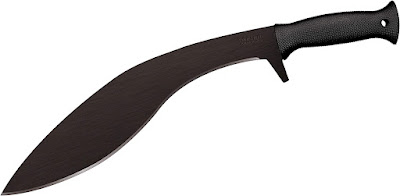 |
Not actually Erin. & is used with permission. |
One of the "joys" of middle age is a loss of flexibility, strength and resilience, and a corresponding increase in aches, pains, and susceptibility to injury. One of the many ways this affects me is that I must carefully consider how much weight I can carry in a Bug Out or Get Home Bag without hurting myself.
Some heavy objects, like food, are a self-correcting problem in that my pack will get lighter as I consume them. Other items, like water and shelter, are too necessary for survival to remove from my pack. The real issue for me is when I get to the "Nice to have, but are they needed?" items, typically tools like a shovel, a saw, and an axe/hatchet.
The following is not so much This is how I solved my problem and more like These are my thoughts and I'd like to know what you think.
Cutting Wood
I don't foresee the need to cut down trees as part of my Bug Out or Get Home preps, just a need to harvest and process firewood. This means I can leave the axe at home. But what about a hatchet?
Unfortunately, at this point I can't justify the weight of a hatchet, especially since it's a tool where weight is needed to do the job properly. Instead I have decided to make do with my
Cold Steel Kukri Machete, which has served me well for over a decade of hard use and which I've used to chop down saplings and limb larger trees for my mother's backyard garden. I know it will chop most anything I need it to chop, and it does a better job as a hatchet then a hatchet will as a machete when clearing brush -- which is a real need for me in this dense Florida undergrowth.
In case there's something I can't chop, I have a
Corona Tools folding 10-inch saw which is sharp, lightweight (less than a pound), and quite compact. It will easily cut branches up to six inches thick, which is far more than I need it to do.
I think that between these two tools I have a solution for cutting anything which I will reasonably need cut during an emergency which doesn't involve me staying at home.
Moving Earth
This dilemma is a lot harder to solve than the previous one, and it has occupied my mind for a while now. The problem with camp shovels, aka entrenching tools, is that their decreased weight comes with a concurrent decrease in size in both length and width, meaning that I will be hunched over a lot and digging harder than I would with a longer, and heavier, but proper earth-moving tool.
In other words, my back is going to be killing me regardless; I just get to choose if I want it to hurt while traveling or while digging.
However, after an embarrassingly long time, I eventually came to this conclusion:
I don't need a shovel at all. Much like with my wood cutters above, my earth moving needs will be minimal. I can't foresee myself needing to dig a pit; at most, I'll only need to dig small holes between six inches to a foot in depth (such as a
cathole). I already have a tool designed for just such a purpose: a
Hori Hori, which is also known as a gardening trowel.
This is a full-tang "knife" designed for digging, with a serrated edge good for sawing through roots. I can use it to dig fire pits and latrines, cover hot coals and ash with dirt, even forage for roots and tubers with it. I gave these out as gifts for Christmas 2017, and Lokidude reviewed it
in this post.
While none of these will properly replace a shovel, an axe/hatchet, and a saw, the point of this post is that they don't need to replace anything. Instead, I just needed to re-frame my tool needs for my anticipated situations, and find something which addresses those needs while also sparing my aching back. If you find yourself in a similar dilemma, I recommend you do the same thing: stop asking yourself "How can I make X thing lighter/smaller" and start asking "Do I really need an X thing at all, or can I get by with reduced capability?"
Let me know how this turns out for you.
































